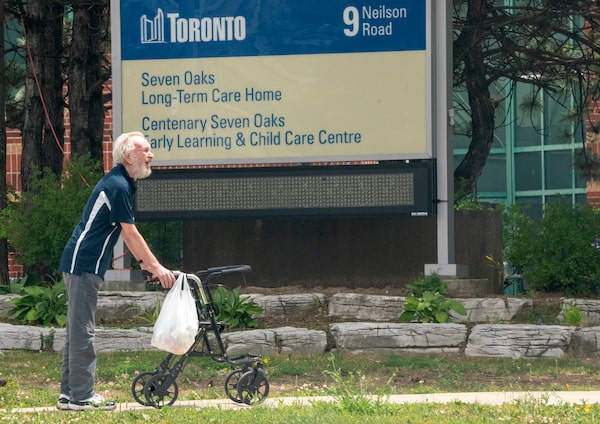
A man takes a walk outside the Seven Oaks Long-Term Care Home in Toronto on June 25, 2020.Frank Gunn/The Canadian Press
Ontario is loosening restrictions on visits to long-term care facilities and changing the way it funds the construction of seniors’ homes in a bid to build more beds in the province.
But critics say the new funding model, which provides more generous financial incentives for owners of homes, does nothing to address the staffing crisis and poor quality of care that vulnerable seniors received as COVID-19 outbreaks ravaged Ontario’s long-term care facilities.
Merrilee Fullerton, Minister of Long-Term Care, said Wednesday that effective immediately, up to two people can now visit their loved ones outdoors at long-term care facilities that don’t have outbreaks, without having to take a COVID-19 test. Starting on July 22, indoor visits can also resume, as long as visitors attest to having a negative test within two weeks.
“I know that this has been incredibly difficult for many, including loved ones, essential caregivers and families,” Ms. Fullerton said.
Earlier in the day, the National Institute on Ageing had called on the government in a report on Wednesday to reopen homes to family caregivers during the pandemic, saying visitor policies are overly restrictive, inequitable and potentially harmful.
“Many residents have sustained severe and potentially irreversible physical, functional, cognitive, and mental health declines,” said Nathan Stall, a geriatrician and associate fellow at the institute who led the report.
Dr. Stall said the new policy still doesn’t differentiate between family caregivers and visitors and called on the government to do more.
The government also provided new details about a previously announced $1.75-billion investment for long-term care facilities. The money was intended for 15,000 new beds and to redevelop 15,000 existing beds over five years.
Ministry officials said the new formula will pay builders more, and include grants to cover up to 17 per cent of upfront capital costs.
Premier Doug Ford said Wednesday that money will fund 8,000 new beds and 12,000 redeveloped beds, and the government is “committed” to building 30,000 beds over the next decade.
The province also promised that all new long-term care facilities, and those being renovated, will have air conditioning.
Jane Meadus, a lawyer at the Advocacy Centre for the Elderly, said she has concerns around the roughly three years it could take to build new homes.
In Toronto, thousands of long-term care beds are in older homes. “What is the plan for the residents who live there now?” she said. “Where do those people go when the homes are being redeveloped?”
NDP Leader Andrea Horwath said she was “incredibly disappointed” in the announcement, which she hoped would include a commitment to four hours of hands-on care for residents, as well as higher wages and full-time work for personal support workers.
In addition, Mr. Ford’s government has yet to reveal any details of the independent commission into long-term care, which is supposed to start this month. Ms. Horwath called the coming commission “a sham” and reiterated her call for a full judicial public inquiry.
Sharleen Stewart, president of SEIU Healthcare, the union that represents 60,000 front-line health care workers, said the long-term care sector continues to be unprepared for the fall flu season and subsequent waves of COVID-19.
“What the provincial government announced will do nothing to guarantee that we’ll have enough workers to provide quality care today, let alone in the future,” she said.
But the Ontario Long Term Care Association, which represents 70 per cent of the province’s 630 long-term care homes, praised the decision to change the way projects are funded.
“This is an important step forward to secure the sector’s sustainability now and into the future, as 36,000 seniors in need remain on the wait list and Ontario’s population over 80 is set to double in the next 13 years,” chief executive officer Donna Duncan said.
Of the 78,433 long-term care beds in Ontario, just more than 26,000 are in homes that need to be redeveloped. Many of these older homes contain four-bed wards even though the province changed its standards in 1998, mandating that each bedroom can house no more than two residents.
Despite successive governments pledging to finance the construction of new beds, little has happened. Outbreaks of COVID-19 in crowded nursing homes with ward beds tended to be larger.
Samir Sinha, director of geriatrics at the Mount Sinai and University Health Network hospitals in Toronto, questioned why the government is so focused on building new homes when it can provide nursing care to elderly people in their own homes for much less money.
With report from The Canadian Press
Our Morning Update and Evening Update newsletters are written by Globe editors, giving you a concise summary of the day’s most important headlines. Sign up today.
 Laura Stone
Laura Stone Karen Howlett
Karen Howlett